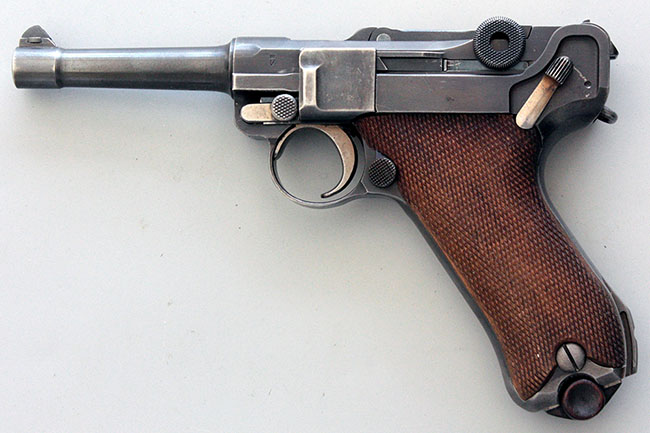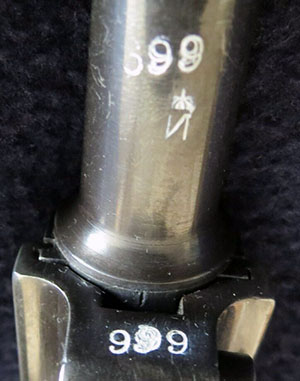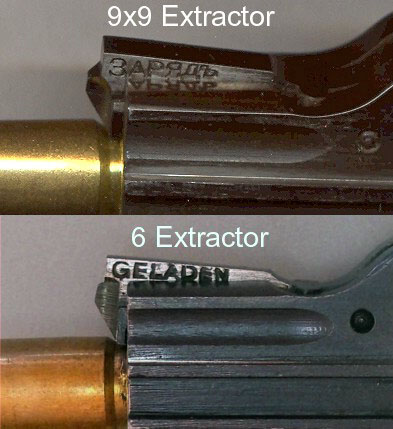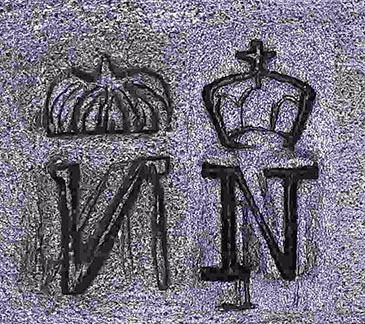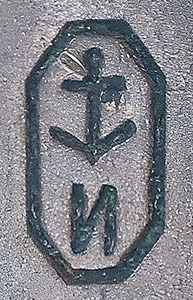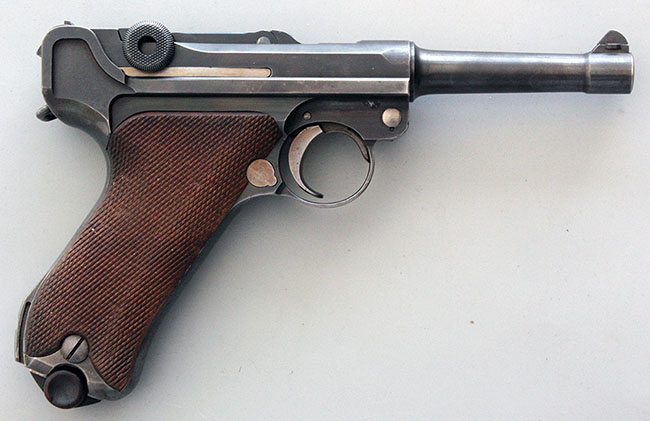 |
||||||||||||||||||||||||||||||||||||||||||||||||||||||||||||||||||||||||||||||||||||||||||||||||||||||||||||||||||||||||||||||||||||||||||||||||||||||||||||||||||||||||||||||||||||||||||||||||||||||||||||||
|
The Russian Crown/И Luger by Ed Dittus March 2025 I have had a string of recent acquisitions that were somewhat odd. First were two related Lugers that formed the impetus for my article on the so called “1906 Test Lugers”. Then, from the same sainted dealer, I purchased the pistol that is the subject of this piece: the “Russian Commercial”, so named by Jones (1959). “It is a rare bird” Mr. Schmitz averred as he sent me an entry from the Jones book which showed an example in all it's glory. An oddity at a reasonable price … I told him “send it”.
As is so often the case with Lugers, particularly with ones that are a bit offbeat, a yawning chasm of a rabbit hole lurked beneath the somewhat everyday look of the pistol. Herewith is the story. I want to be clear that I have no particular axe to grind regarding this pistol. Whether it is “Russian” or something else is, without more data, unknowable. Please also note well that this article in no way concerns or is related to the 1906 “Crossed Rifle / Russian Contract” pistols. The purpose of this paper is to, hopefully, query the broader collecting fraternity regarding similar examples to the gun pictured above, and/or for any information. I will attempt to offer some food for thought. I use the name “Russian Commercial” without endorsing it as an ironclad identification. I think collectors that are familiar with the markings on these pistols know it by that name, so it is used as a matter of convenience. To begin, a diligent examination of the literature (American/English) turned up a total of seven references that referred to this pistol. The mentions are brief and will be summarized here. A lengthy exploration of the Internet yielded nothing, though there were three topics on the Jan Still Luger boards, one of which was started by me. On the Luger Boards there was one thread back in 2017 that received no replies. So the task that has fallen to me is less to summarize and explicate than to attempt to create something solid out of smoke and, hopefully, encourage any reader with information to publish it or to contact me.
Brief Summary of the Object in Question For those not familiar with the subject of this paper, the so called “Russian Contract” Luger is a commercial Luger whose sole distinction is a mark that looks like a crowned Cyrillic character. There are very few examples. They generally have no marks other than the Crown/И and a low serial number on the frame and, sometimes, on the barrel. The serial number might appear internally on a few parts. That is, essentially, it. There is disagreement on almost every aspect of these guns and I will endeavor to share the thoughts of other collectors with you. (As as aside, this is a case where having a comprehensive index of the NAPCA journal Automatic Magazine would have been very useful. Perhaps we can, as an organization, make that happen rather than have all that precious information vanish, like tears in the rain, to steal a good use of English.) The Examples There are two examples in collectors’ hands that I know of. There is also one illustrated by Jones (1959). Costanzo (1977) refers, irritatingly obliquely, to other examples that might be of virtually any number.
The Russian Crown/И Luger This firearm is, essentially, a commercial New Model Luger in 7.65mm. It consists of a number of characteristics that might be in common with a 1914 model too. It has flat pads on the toggle, a short sear bar, and a factory installed hold open (identified by the lack of an associated inspection mark). Any serials present are placed in the commercial (hidden) manner. What sets these pistols apart from all other Lugers (and every other pistol too, as far as I have been able to determine) is the presence of a Proof/acceptance mark that consists of a Crown over a reversed “N”, thus:
This Crown/И mark appears on the trigger plate in all 3 observed cases and, in two cases (numbers 9 & 9X9), on the barrel. Note that there is a slight imperfection in the die on the top of the right leg of the “И”. All three stamps have a similar shape and appear to have been made by the same die. I have had the opportunity to examine serial number 5 in minute detail. How generalizable my findings are to other examples is an open question. Serial number 5 has its serial number stamped on the bottom the the rear toggle. It has no markings of any kind internally: no “Flaming Bomb” in the barrel lock recess, nor a Catherine Wheel in the barrel ring, and no serial number on the stop. It has likewise been stated that serial number 9X9 has “no markings on any small part”. Reading Jones' comments on serial number 9, he suggests that on that pistol the reversed "N" mark and the serial appear on the barrel with only the serial on the frame front (presumably) and the "N" on the left side of the receiver. The only mark that one can see on the photos is the "N" on the receiver A difference from every other Luger in my collection and a characteristic that I thought, up until now (are you REALLY surprised, Ed?), was present on all Lugers is the witness mark on the barrel, or the lack thereof.
I found that neither Crown/И pistol I was able to examine had one. Dwight Gruber informs me that “some very late DWM production Lugers sold by Mauser (often police) have a receiver mark but no barrel mark”.
Two examples (serial numbers 5 and 9) have German language stamps on the extractor and under the safety lever (i.e., “Geladen” and “Gesichert”: “Loaded” and “Secured”). One, serial number 9X9, has the Russian inscription “ЗАРЯДЪ“ (Loaded) on the extractor and no marking under the safety. This gives one pause. The fact that neither of the other examples have this mark, which one would assume would be a commonplace for an export arm, raises more questions than it answers. It does, however, provide a bit of support for the contention that this pistol, and it's brothers, have a real Russian connection. Again, we await more examples. Finally, all three examinable examples have the word “GERMANY” stamped on the receiver, above the chamber, in letters about 2mm tall. Notes on Fit and Finish Some have commented that this is a “parts gun”, that is to say cobbled together from odd pieces and made to look like something a factory produced. I can only comment on the example that I have at hand. Examining that pistol closely, it looks as fine an example as the best in my collection. The owner of serial 9x9 has confirmed to me that his example, too, is finely made. Could some vagabond expert forger have made some number of these guns to deceive? Certainly. But I think not. It's condition and lack of proofs or other factory markings are consistent with what is commonly referred to as “Lunch Box Lugers”, Lugers that were removed piecemeal (in a lunchbox) and reassembled off site for illegal sales. Such activities might be informal or, potentially, through the activities (dare I say “collusion”) of management. The Literature <sigh> The earliest reference to this pistol that I could find is from Jones (1959). In that book the author provides an illustration and summary of the example he (presumably) examined. It is also the first use of the name “Russian Commercial”. His discussion is somewhat confused and suggests that the pistol in question might either be a 1914 “Russian Contract” pistol or a 1923 model. I should note that the example in Jones was from the James N. Belford collection. Belford was a collector of some note and in 1969 wrote the book (along with Jack Dunlap) “The Mauser Self Loading Pistol”. I mention this since Mr. Belford had some sophistication when it came to identifying pistols. A diligent search turned up no mention of the disposal of the Belford Collection after his death in 1979.
The net of the literature wisdom is, in reality, a reflection of how little we know. What does the Crown/И signify? A regular criticism of the hypothesis of a Russian connection for these pistols is that a circa 1920 Luger would hardly bear a mark including a CROWN inasmuch as the Russian revolution did away with such things. Fine and good, but it should be remembered that the revolution did not end until 1923. Plus it is not clear that these pistols were actually manufactured in or after 1920. They might well date from 1914 (though the lack of a barrel witness mark suggests a later date). There are no internal marks to help us date them more precisely. There is no compelling argument for these weapons either having or not having a Russian connection. It also behooves us to remember that the Cyrillic alphabet is used in writing Russian, Ukrainian, Serbian, Bulgarian, Macedonian, Belarusian, Kazakh, Uzbek, Kyrgyz, Tajik, Gagauz, and Mongolian. I am not implying a Tajikistan or other connection for this weapon, but I am not denying it either. We simply do not know. Note that the Cyrillic reversed “N” might stand for Инспектировать or “Inspect”. Thus indicating some level of government involvement in production. Another possibility is “Императорский” or “Imperial”. But such speculation is not terribly productive. We should also recall that hyperinflation was crippling Germany in the early 1920's. It is not terribly difficult to understand that a company like DWM, or perhaps some employees thereof, might produce pistols to meet a demand where they found one. Russian Royalists buying weapons is not beyond the realm of possibility. The Crown in the mark is interesting. Compare it to the Crown that is ubiquitous on German firearms.
There is no cross surmounting it, and it has a shape reminiscent of a cap rather than the imposing presence of a crown. I have been unable to find any other image close to it. But I think that it knows more than it is telling. To me, it has something of an Eastern flavor. Finally, there is this:
It is a proof or manufacturer's mark on a 1905 Russian torpedo fuse1. So the reversed “N” appears more than once on weaponry. The bottom line is that the jury is out on the meaning of the Crown/И mark.
Over the years a number of criticisms have been leveled at these pistols. I will mention a few and attempt to address them.
So what is it?
In my humble opinion, this Luger and it's mates, are what they purport to be: Production pistols diverted from the inspection and proofing process and custom numbered and marked. That is a minimalist assumption and begs the questions: “Why? For whom? When?” My minimalist assumption is fairly supportable upon examination of the objects in question. More than that is guesswork. One gentleman has suggested that some European princely house contracted for these Lugers to arm a personal army. Another gentleman thought it was possible that emigre groups were staging an insurgency after the Russian revolution. Both are possible, but to my mind unlikely. At least one of the extant pistols is in excellent condition. It does not seem to have been tested, or even shot. I think this provides at least some support for the notion that these pistols were diverted to the US, or at least there was hope that they would be shipped here. The GERMANY stamp makes no sense for a product destined for Russia. Of course, one might also point out that a Cyrillic stamp makes no sense for a product destined for the USA. Ahhh … Lugers. I suspect that these are “lunch Box Lugers”, that is to say pistols that were removed from the factory in parts via the lunch box (metaphorically) route. Whether with or without the knowledge and participation of management remains unknown. My personal opinion is that this pistol, and it's brothers, were destined for Russia. Whether samples against a larger potential contract or simply under the table as illegal arms is simply unknowable. I think that the answer is as mundane as that. They never quite made it there and then got diverted to the US. This might make sense inasmuch as the “GERMANY” stamp is only relevant if the object in question was intended for shipment to the US. The US required an indelible indication, in English, of the country of origin. Conclusion There you have it. Another “Russian” riddle wrapped in a mystery inside an enigma. I suspect that more of these pistols are out there and it is my hope that this article will “shake the tree”, so to speak, and produce more examples to help us understand what these fascinating pistols are.
1. https://www.reddit.com/r/russian/comments/1akyy4z/understanding_this_imperial_russian_factory/ For the sake of completeness and for the convenience of anyone who wishes to follow me down this Rabbit Hole, I have added links to the few threads on this topic that I have been able to find. Note that I did not specifically search more general “Gun” forums.
References For the “Russian Commercial” Luger
Acknowledgments Once again, thanks to Ed Buffaloe for his expert help in making this paper cogent. Also thanks to Larry “Kyrie” Ellison for sharing his rarity with me (and you all) and his thoughtful ruminations on the piece. Thanks again to Will Schmitz of NewMexicoFirearms@Yahoo.com for another interesting Luger. |
||||||||||||||||||||||||||||||||||||||||||||||||||||||||||||||||||||||||||||||||||||||||||||||||||||||||||||||||||||||||||||||||||||||||||||||||||||||||||||||||||||||||||||||||||||||||||||||||||||||||||||||
|
Copyright 2025 by Ed Dittus. All rights reserved. |
||||||||||||||||||||||||||||||||||||||||||||||||||||||||||||||||||||||||||||||||||||||||||||||||||||||||||||||||||||||||||||||||||||||||||||||||||||||||||||||||||||||||||||||||||||||||||||||||||||||||||||||
|
|
||||||||||||||||||||||||||||||||||||||||||||||||||||||||||||||||||||||||||||||||||||||||||||||||||||||||||||||||||||||||||||||||||||||||||||||||||||||||||||||||||||||||||||||||||||||||||||||||||||||||||||||
